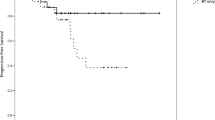Abstract
The standard treatment in children with average-risk medulloblastoma (MB) is reduced-dose radiotherapy (RT) followed by chemotherapy. However, in adults, there is no agreement on the use of adjuvant chemotherapy. We performed a retrospective analysis of adult MB patients with average-risk disease, defined as no postsurgical residual (or ≤1.5 cm2) and no metastatic disease (M0). Main inclusion criteria were: age >16 years, post-surgical treatment with craniospinal irradiation with or without adjuvant chemotherapy (cisplatin and etoposide ± cyclophosphamide). From 1988 to 2012 were accrued 43 average-risk MB patients treated with surgery and adjuvant RT. Fifteen (34.9 %) patients received also chemotherapy: 7 before RT, 5 after RT, and 3 before and after RT. Reasons to administer chemotherapy were presence of residual disease (even if ≤1.5 cm) and delay in RT. After a median follow up time of 10 years (range: 8–13), median survival was 18 years (95 % CI 9–28) in patients who receive RT alone, and was not reached in patients treated with RT plus chemotherapy. The survival rates at 5, 10 and 15 years were 100 %, 78.6 % (95 % CI 60.0–97.2 %) and 60.2 % (95 % CI 36.9–83.5 %), in patients treated with RT alone, and 100, 100 and 100 %, in patients treated with RT plus chemotherapy (p = 0.079). Our findings suggest a role for adjuvant chemotherapy in the treatment of average-risk MB adult patients. Further improvements might drive to add chemotherapy in average-risk setting with less favourable biological signatures (i.e., non-WNT group).

Similar content being viewed by others
References
Smoll NR, Drummond KJ (2012) The incidence of medulloblastomas and primitive neurectodermal tumours in adults and children. J Clin Neurosci 19:1541–1544
Brandes AA, Franceschi E, Tosoni A et al (2007) Long-term results of a prospective study on the treatment of medulloblastoma in adults. Cancer 110:2035–2041
Padovani L, Sunyach MP, Perol D et al (2007) Common strategy for adult and pediatric medulloblastoma: a multicenter series of 253 adults. Int J Radiat Oncol Biol Phys 68:433–440
Chang CH, Housepian EM, Herbert C Jr (1969) An operative staging system and a megavoltage radiotherapeutic technic for cerebellar medulloblastomas. Radiology 93:1351–1359
Packer RJ, Goldwein J, Nicholson HS et al (1999) Treatment of children with medulloblastomas with reduced-dose craniospinal radiation therapy and adjuvant chemotherapy: a Children’s Cancer Group Study. J Clin Oncol 17:2127–2136
Packer RJ, Gajjar A, Vezina G et al (2006) Phase III study of craniospinal radiation therapy followed by adjuvant chemotherapy for newly diagnosed average-risk medulloblastoma. J Clin Oncol 24:4202–4208
Brandes AA, Ermani M, Amista P et al (2003) The treatment of adults with medulloblastoma: a prospective study. Int J Radiat Oncol Biol Phys 57:755–761
Brandes AA, Pasetto LM, Lumachi F et al (2000) Endocrine dysfunctions in patients treated for brain tumors: incidence and guidelines for management. J Neurooncol 47:85–92
Brown AP, Barney CL, Grosshans DR et al (2013) Proton beam craniospinal irradiation reduces acute toxicity for adults with medulloblastoma. Int J Radiat Oncol Biol Phys 86(2):277–284
Friedrich C, von Bueren AO, von Hoff K et al (2013) Treatment of adult nonmetastatic medulloblastoma patients according to the paediatric HIT 2000 protocol: a prospective observational multicentre study. Eur J Cancer 49:893–903
Kortmann RD, Kuhl J, Timmermann B et al (2000) Postoperative neoadjuvant chemotherapy before radiotherapy as compared to immediate radiotherapy followed by maintenance chemotherapy in the treatment of medulloblastoma in childhood: results of the German prospective randomized trial HIT ‘91. Int J Radiat Oncol Biol Phys 46:269–279
Tarbell NJ, Friedman H, Polkinghorn WR et al (2013) High-risk medulloblastoma: a pediatric oncology group randomized trial of chemotherapy before or after radiation therapy (POG 9031). J Clin Oncol 31:2936–2941
Gajjar A, Stewart CF, Ellison DW et al (2013) Phase I study of vismodegib in children with recurrent or refractory medulloblastoma: a pediatric brain tumor consortium study. Clin Cancer Res 19:6305–6312
Rodon J, Tawbi HA, Thomas AL et al (2014) A phase 1, multicenter, open-label, first-in-human, dose-escalation study of the oral hedgehog inhibitor Sonidegib (LDE225) in patients with advanced solid tumors. Clin Cancer Res 20:1900
Brandes AA, Franceschi E (2014) Shedding light on adult medulloblastoma: current management and opportunities for advances. Am Soc Clin Oncol Educ Book 34:e82-7
Brandes AA, Franceschi E (2010) Neuro-oncology: genetic variation in pediatric and adult brain tumors. Nat Rev Neurol 6(12):653–654
Brandes AA, Franceschi E, Tosoni A et al (2009) Adult neuroectodermal tumors of posterior fossa (medulloblastoma) and of supratentorial sites (stPNET). Crit Rev Oncol Hematol 71(2):165–179
Brandes AA, Paris MK (2004) Review of the prognostic factors in medulloblastoma of children and adults. Crit Rev Oncol Hematol 50(2):121–128
Authors’ contribution
EF. conceived the study and participated in its design, coordination and draft. M.B. participated in the coordination and draft of the study. A.P. carried out the statistical analysis. G.M. carried out histopathological diagnosis. R.A. did the neuroradiological evaluations. L.V. performed surgery and provided patients. D.D. carried out histopathological diagnosis. C.G carried out histopathological diagnosis. M.P.G. carried out histopathological diagnosis. C.S. performed surgery and provided patients. R.P. participated in data collection. M.M. provided data about radiotherapy treatment. D.B. provided data about radiotherapy treatment. B.M. performed surgery and provided patients. A.A.B conceived the study and participated in its design, coordination and draft.
Author information
Authors and Affiliations
Corresponding author
Ethics declarations
Conflict of interests
The authors declare that they have no conflict of interests.
Rights and permissions
About this article
Cite this article
Franceschi, E., Bartolotti, M., Paccapelo, A. et al. Adjuvant chemotherapy in adult medulloblastoma: is it an option for average-risk patients?. J Neurooncol 128, 235–240 (2016). https://doi.org/10.1007/s11060-016-2097-x
Received:
Accepted:
Published:
Issue Date:
DOI: https://doi.org/10.1007/s11060-016-2097-x




